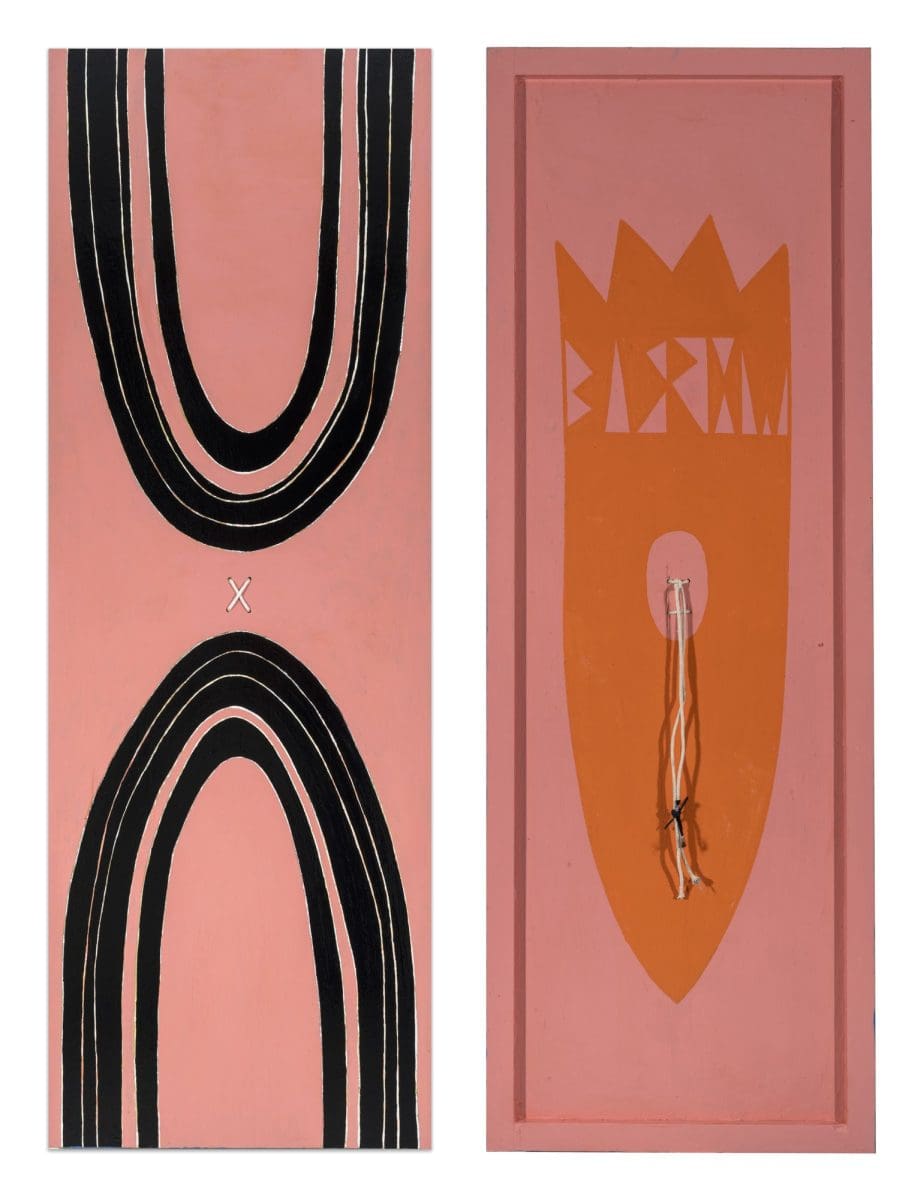
Piercing the veil
A new exhibition at Buxton Contemporary finds a rich complexity in the shadowy terrain between life and death.
The Kuman shield is intrinsic to Yuriyal Eric Bridgeman’s practice, with the artist’s vibrantly painted shields speaking to heritage, ritual and sport.
A shield, most generally, provides symbolic and material protection—think of the highly decorative shields used in combat across numerous cultures throughout history. Shields have a broad resonance but are also specific cultural and historical records— determined by who has made, decorated and used them.
Multidisciplinary artist Yuriyal Eric Bridgeman incorporates references and representations of Kuman, traditional Papua New Guinean shields, in his work. He combines these painted allusions to shields alongside photography, installation, and other painting, conjuring suggestions to abstract art and rugby league.
Bridgeman, who works and lives in Brisbane and in Wahgi Valley, Jiwaka Province, Papua New Guinea, started out as a photographer. Speaking of his practice he says, “Painting is not my first language. I began as a photographer. Portraiture was my thing. I only learned to paint through time with my family and brothers in the village. Our language being that of the Kuman or shield,” explains Bridgemen, referring to the Kuman shields, made by his people, the Yuri tribe of the Gumine District Simbu Province.
Kuman are handcrafted shields—which use bold, optically striking motifs—following a tradition that has been passed on for countless generations. Tradition here can be better understood as something that is historically rich, storied, and lively—rather than something that’s of the past. Bridgeman tells me, “We simply refer to our contemporary work as ‘Shield Paintings’.” The craft of shield making is not only a part of contemporary practice—to a degree, it defines contemporary practice.
For the 2019 iteration of The National, Bridgeman presented a collection of paintings, bustling with colour and striking marks, alluding to the geometric patterns of shields. The work, titled Sikiram / Büng / Scrum, 2019, is a series of painted panels, some on board, some on canvas, some made with enamel and others with acrylic paint. Huddled together on the wall, the collection of energetically coloured, bold paintings evokes the stalled intensity of the rugby scrum.
In rugby league, the scrum is a means of restarting the game after the ball has gone out of play. In this moment of spectacle, players from each team pack closely together in three rows and interlock their heads and arms with those of the opposing team. There’s sweat from the clashing bodies, dirt from the field, moans and grunts from the players, shouts from the referee and the fans.

Rugby league is not only referenced in the title and subtly in the lines and the colours of Bridgeman’s paintings, but in that it is a sublimation—or staged— form of warfare. Speaking of his artistic influences, Bridgeman adds, “I would also place rugby league in the column of artistic influences. Visually and methodically, through movement, formation and design, it is a source of artistic and human nourishment,” he explains. “There is a strong parallel that exists between rugby league, tribal warfare and peace building, particularly in artistic design, choreography and patterning, which is of great interest to me.”
In Sikiram / Büng / Scrum the paintings are neither literal representations of shields or rugby league players, but they are charged with a choreographed energy to symbolically suggest combat, tradition, spectacle, and sport. One might recall the work of French sociologist Pierre Bourdieu who developed his interest in sport, combat, and ‘the field’ into theories of class and cultural capital. Bourdieu, like Bridgeman, understood the interconnected cultural, social, physical, and artistic values of sport.
Bridgeman’s art may be considered among the work of contemporary Indigenous artists such as Brook Andrew, Reko Rennie, Jonathan Jones, and Kent Morris, who also reference shields in their artwork. Yet Bridgeman’s shields are highly specific and derive directly from his lived experience as a member of the Yuri tribe.
“Continuing to make shield paintings is my connection to my brothers and my tribe. Just like how supporting the Parramatta Eels and wearing the jersey connects me to them. I wear it on my skin, as a reminder . . . Some have commented that the shields I make are portraits of myself . . . and I can’t disagree, because I am aware of the emotion and energy I have projected onto it,” says Bridgeman.
It makes sense then that Bridgeman’s exhibition for the forthcoming Liveworks Festival of Experimental Art, presented by Performance Space on Gadigal Country and Home of the Arts (HOTA) on Yugambeh Country, continues with his multi-modal approach to drawing the energy of varied allusions. For this work, Bridgeman tells me, “The shields I have created belong to me, as they come from my heart and body. The designs reference core principles of traditional shields. The shapes and colours form stories, if not individually, then collectively.”
Perhaps Bridgeman’s paintings do become shields in the end—for how they both protect and maintain his connection to family and culture, and, as he mentions, his own emotional nourishment. Art like rugby, may well be a sanitised—if only partially—mode of warfare.
A barrow, a singsing,
Liveworks Festival of Experimental Art
Carriageworks (Sydney NSW)
20 October—30 October
This article was originally published in the September/October 2022 print edition of Art Guide Australia.